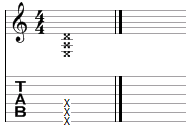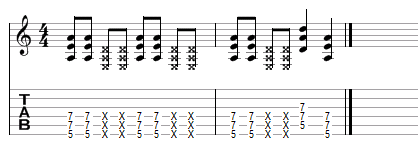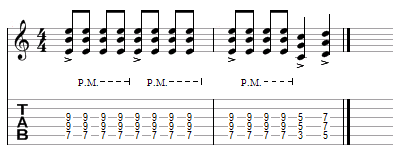Muting is a commonly used technique to dampen the sound of the strings. There are a number of uses for doing this.
The first reason for dampening the strings is too produce an a-tonal percussive sound. In tab notation its displayed using ‘x’s.

Basically this is telling us to hit the strings marked with an ‘x’ but without fretting any notes. To do this we need to dampen the strings, so that when we strike them, it makes a noise but doesn’t play any notes.
In order to do this we need to lay our fretting fingers over the strings, so that they are touching the strings, but we don’t press down onto any frets. This way when we strike the strings it should produce a dull percussive sound.
This technique works best the more fingers you use. If you can, aim to use at least three fingers, or even better use all four. The more fingers you use the better the strings are dampened. Also if you only use one finger you may accidentally play a natural harmonic. Natural harmonics have a bell like chiming sound, which isn’t what we are aiming for when muting.
This kind of muting can add a nice percussive edge and chunkiness to riffs. Here is an example.

Listen to how it sounds.
This kind of muting is also used sometimes to fill in spaces where you want to have sound, but may not want specific notes. Depending on where you mute the strings along the neck will produce different muted sounds. Generally speaking we would just mute in a place close to the other notes or chords we are playing just to make things easier.
The second very common type of muting is called palm muting. It is a way of dampening the strings to stop them sustaining or ringing after they are struck, but at the same time playing the notes rather than going for a percussive sound as before.
In tab notation it will look like this.

The ‘P.M’ followed by the dashed line hovers above the notes or chords means we want to palm mute. So we can see from this example the 1st chord is played normally, but the next three are palm muted. Then we have a normal played chord followed by three palm muted again.
To actually play a palm mute we need rest our picking hand on the bridge string saddles. This will dampen the strings but at the same time allow the notes to play. Aim to rest the side of your picking hand directly on top of the bridge saddles this will produce the best balance between the muting sound and the notes. Placing your hand too far forward will over do the muting effect muffling the notes too much.
Listen to the above example being played.
This example was played with a lot of distortion. Palm muting is a very important and often used technique when playing with distortion. Since guitar strings sustain longer and are more sensitive when playing with distortion, palm muting is a good way to help control excess noise and sound we may not want.
It also used because of the sound it makes. It adds a nice solid chunkiness to the notes. This chunkiness is very popular in rock and metal. It also helps to create a nice contrast between the muted and non-muted notes. When the chords we play in the example aren’t palm muted they stand out stronger next to the muted chords.
You can here the same riff played without any palm muting.
It has a more aggressive and noisy sound.
Depending on the type of song and music you are playing you may choose to use either.
These types of muting are very common and are prevalent in many types of music. Well worth learning!
- Muting notes adds contrast between non muted notes.
- Muting can add a more percussive sound.
- Muting can help drive rhythms.
